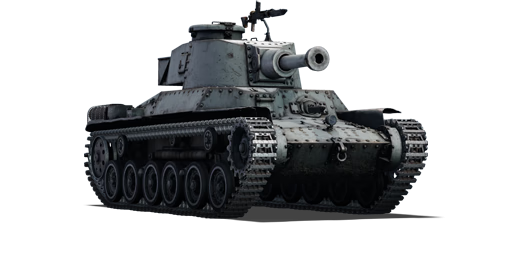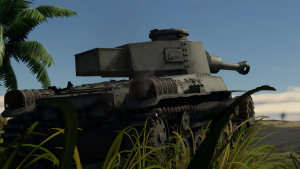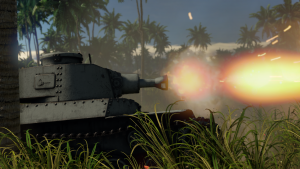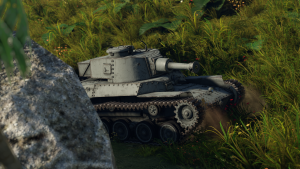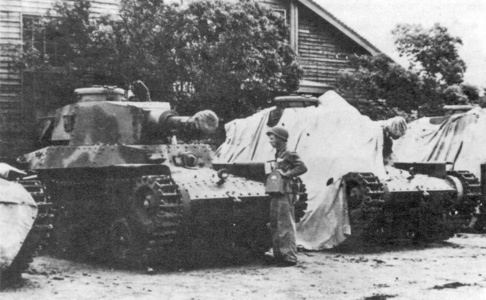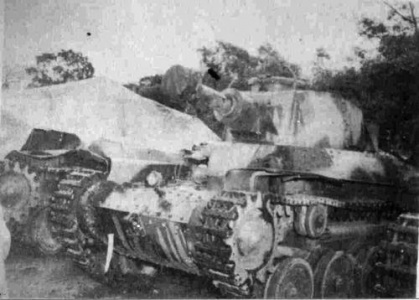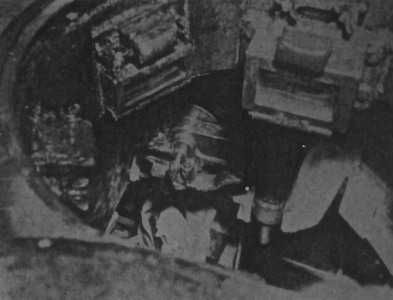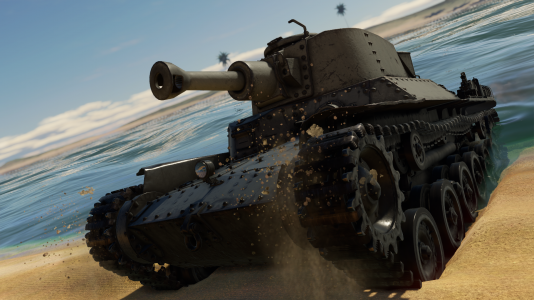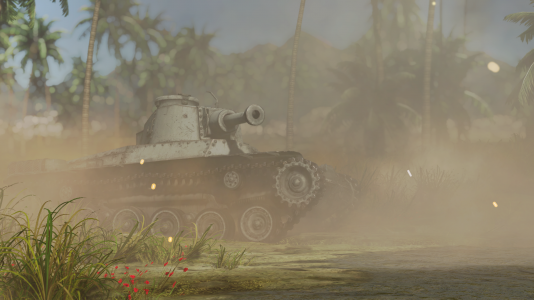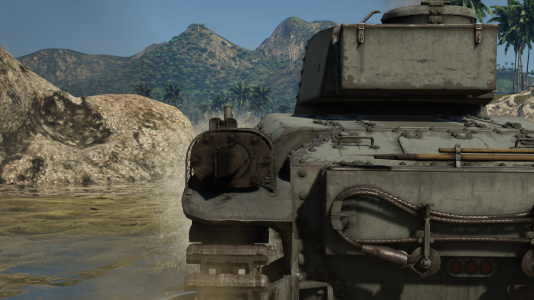Difference between revisions of "Chi-Ha Short Gun"
Inceptor57 (talk | contribs) m (→Usage in battles) |
|||
| Line 16: | Line 16: | ||
The {{PAGENAME}} is a Naval refit of the [[Chi-Ha Kai]] with a [[Navy short gun (120 mm)]], it keeps the decent mobility from the [[Chi-Ha (Family)|Chi-Ha]] chassis but loses the turret rotation speed due the added weight of the gun. | The {{PAGENAME}} is a Naval refit of the [[Chi-Ha Kai]] with a [[Navy short gun (120 mm)]], it keeps the decent mobility from the [[Chi-Ha (Family)|Chi-Ha]] chassis but loses the turret rotation speed due the added weight of the gun. | ||
| + | |||
== General info == | == General info == | ||
| + | [[File:{{PAGENAME}}_(2).png|thumb|left|300px|{{PAGENAME}} scanning the seaside]] | ||
| + | |||
The Type 97 [[Chi-Ha]] is an upgraded version of the earlier Type 89 [[I-Go Ko]]. The engine has been upgraded, from the Mitsubishi A6120VD air-cooled straight-six diesel with 120 hp to a Mitsubishi SA12200VD air-cooled V12 diesel with 170 hp. As such, the top speed has increased from 27 km/h on the [[I-Go Ko]] to 40 km/h on the [[Chi-Ha]]. | The Type 97 [[Chi-Ha]] is an upgraded version of the earlier Type 89 [[I-Go Ko]]. The engine has been upgraded, from the Mitsubishi A6120VD air-cooled straight-six diesel with 120 hp to a Mitsubishi SA12200VD air-cooled V12 diesel with 170 hp. As such, the top speed has increased from 27 km/h on the [[I-Go Ko]] to 40 km/h on the [[Chi-Ha]]. | ||
The {{PAGENAME}} is a later iteration of the [[Chi-Ha]] with a modified turret coming from the [[Chi-Ha Kai]]. For firepower the {{PAGENAME}} has a [[Navy short gun (120 mm)]] that launches 13 kg HE shells. | The {{PAGENAME}} is a later iteration of the [[Chi-Ha]] with a modified turret coming from the [[Chi-Ha Kai]]. For firepower the {{PAGENAME}} has a [[Navy short gun (120 mm)]] that launches 13 kg HE shells. | ||
| + | |||
| + | Which was made to support navy infantry as a gun tank during the defense of the homeland. | ||
=== Survivability and armour === | === Survivability and armour === | ||
<!-- Describe armour protection. Note the most well protected and key weak areas. Appreciate the layout of modules as well as the number and location of crew members. Is the level of armour protection sufficient, is the placement of modules helpful for survival in combat? If necessary use a visual template to indicate the most secure and weak zones of the armour.--> | <!-- Describe armour protection. Note the most well protected and key weak areas. Appreciate the layout of modules as well as the number and location of crew members. Is the level of armour protection sufficient, is the placement of modules helpful for survival in combat? If necessary use a visual template to indicate the most secure and weak zones of the armour.--> | ||
| + | |||
Light, but effective against weaker guns (i.e. early French), weaker shells (low-calibre HE), and in long range engagements. | Light, but effective against weaker guns (i.e. early French), weaker shells (low-calibre HE), and in long range engagements. | ||
| Line 63: | Line 69: | ||
=== Main armament === | === Main armament === | ||
<!-- ''Give the reader information about the characteristics of the main gun. Assess its effectiveness in a battle based on the reloading speed, ballistics and the power of shells. Do not forget about the flexibility of the fire, that is how quickly the cannon can be aimed at the target, open fire on it and aim at another enemy. Add a link to the main article on the gun: <code><nowiki>{{main|Name of the weapon}}</nowiki></code>. Describe in general terms the ammunition available for the main gun. Give advice on how to use them and how to fill the ammunition storage.'' --> | <!-- ''Give the reader information about the characteristics of the main gun. Assess its effectiveness in a battle based on the reloading speed, ballistics and the power of shells. Do not forget about the flexibility of the fire, that is how quickly the cannon can be aimed at the target, open fire on it and aim at another enemy. Add a link to the main article on the gun: <code><nowiki>{{main|Name of the weapon}}</nowiki></code>. Describe in general terms the ammunition available for the main gun. Give advice on how to use them and how to fill the ammunition storage.'' --> | ||
| + | [[File:{{PAGENAME}}_(4).png|thumb|{{PAGENAME}} firing]] | ||
{{main|Navy short gun (120 mm)}} | {{main|Navy short gun (120 mm)}} | ||
| − | + | The gun from the {{PAGENAME}} is naval short gun built to deal with submarines and close range naval combat, and that does translate over in-game as a gun with lackluster HE filler just enough to destroy light tanks and a very low muzzle velocity, which on the bright side can be used to shoot at vehicles over cover. | |
{| class="wikitable" style="text-align:center" width="100%" | {| class="wikitable" style="text-align:center" width="100%" | ||
|- | |- | ||
| Line 126: | Line 133: | ||
|} | |} | ||
| − | ==== [[Optics]] ==== | + | <!-- ==== [[Optics]] ==== |
{| class="wikitable" style="text-align:center" | {| class="wikitable" style="text-align:center" | ||
! colspan="3" | {{PAGENAME}} Optics | ! colspan="3" | {{PAGENAME}} Optics | ||
| Line 141: | Line 148: | ||
|- | |- | ||
|} | |} | ||
| − | + | --> | |
=== Machine guns === | === Machine guns === | ||
<!-- ''Offensive and anti-aircraft machine guns not only allow you to fight some aircraft but also are effective against lightly armoured vehicles. Evaluate machine guns and give recommendations on its use.'' --> | <!-- ''Offensive and anti-aircraft machine guns not only allow you to fight some aircraft but also are effective against lightly armoured vehicles. Evaluate machine guns and give recommendations on its use.'' --> | ||
| Line 159: | Line 166: | ||
|- | |- | ||
|} | |} | ||
| − | + | {{clear}} | |
== Usage in battles == | == Usage in battles == | ||
<!-- ''Describe the tactics of playing in the vehicle, the features of using vehicles in the team and advice on tactics. Refrain from creating a "guide" - do not impose a single point of view but instead give the reader food for thought. Describe the most dangerous enemies and give recommendations on fighting them. If necessary, note the specifics of the game in different modes (AB, RB, SB).'' --> | <!-- ''Describe the tactics of playing in the vehicle, the features of using vehicles in the team and advice on tactics. Refrain from creating a "guide" - do not impose a single point of view but instead give the reader food for thought. Describe the most dangerous enemies and give recommendations on fighting them. If necessary, note the specifics of the game in different modes (AB, RB, SB).'' --> | ||
| − | + | [[File:{{PAGENAME}}_(5).png|thumb|left|{{PAGENAME}} coming out behind a rock]] | |
Because the {{PAGENAME}} was designed for an infantry support role, its performance shows how tank combat wasn't put in mind for the vehicle. With each shell only having 2.5 kg of explosive, this isn't enough to destroy any vehicle the shell hits; it most likely will shock the crew, but nothing else. | Because the {{PAGENAME}} was designed for an infantry support role, its performance shows how tank combat wasn't put in mind for the vehicle. With each shell only having 2.5 kg of explosive, this isn't enough to destroy any vehicle the shell hits; it most likely will shock the crew, but nothing else. | ||
| − | Most light armored vehicles and tanks (<30 mm armor) will be able to be destroyed from either hull break or crew knock-out wherever you hit. But when you start opposing medium to heavy tanks, you should fallback for friendlies to deal with the target. It might be possible to hit the roof of the turret or hull on these vehicles, but it's a tricky shot and won't always deal a fatal blow on first hit. | + | Most light armored vehicles and tanks (<30 mm armor) will be able to be destroyed from either hull break or crew knock-out wherever you hit. But when you start opposing medium to heavy tanks, you should fallback for friendlies to deal with the target. It might be possible to hit the roof of the turret or hull on these vehicles, but it's a tricky shot and won't always deal a fatal blow on first hit.{{clear}} |
=== Modules === | === Modules === | ||
| Line 220: | Line 227: | ||
== History == | == History == | ||
<!-- Describe the history of the creation and combat usage of the vehicle in more detail than in the introduction. If the historical reference turns out to be too long, take it to a separate article, taking a link to the article about the vehicle and adding a block "/History" (example: https://wiki.warthunder.com/(Vehicle-name)/History) and add a link to it here using the main template. Be sure to reference text and sources by using <ref></ref>, as well as adding them at the end of the article with <references />. This section may also include the vehicle's dev blog entry (if applicable) and the in-game encyclopedia description (under === In-game description ===, also if applicable). --> | <!-- Describe the history of the creation and combat usage of the vehicle in more detail than in the introduction. If the historical reference turns out to be too long, take it to a separate article, taking a link to the article about the vehicle and adding a block "/History" (example: https://wiki.warthunder.com/(Vehicle-name)/History) and add a link to it here using the main template. Be sure to reference text and sources by using <ref></ref>, as well as adding them at the end of the article with <references />. This section may also include the vehicle's dev blog entry (if applicable) and the in-game encyclopedia description (under === In-game description ===, also if applicable). --> | ||
| + | {{main|Chi-Ha (Family)|l1=History of the Type 97 Chi-Ha}} | ||
| − | |||
| − | |||
| − | |||
| − | + | The Short Barrel 120 mm Gun Tank was one variant produced late in the war for the Imperial Japanese Navy. They wanted a gun tank similar to the [[Ho-I|Type 2 Ho-I]] for close support, but with greater firepower. The standard [[Type 1 (47 mm)|47 mm main tank gun]] was replaced with a [[Navy short gun (120 mm)|short barrel naval 12 cm (120 mm) "anti-submarine" gun]] with a muzzle brake added. In addition, it had a small storage compartment added onto the back of the [[Chi-Ha Kai|ShinHoTo Chi-Ha]] turret. Only "about a dozen" were produced for deployment by the Japanese Special Naval Landing Forces.{{clear}} | |
| − | {{clear}} | ||
| − | |||
| − | |||
| − | |||
| − | |||
| − | + | <center>There's only a handful of images of Chi-Ha 120 mm's, all being American and taken at the naval yard in Sasebo, Japan, October 1945.</center> | |
| − | |||
| − | |||
| − | |||
| − | |||
| − | |||
| − | < | ||
| − | There's only a handful of images of Chi-Ha 120 mm's, all being American and taken at the naval yard in Sasebo, Japan, October 1945. | ||
<gallery mode="packed" widths="300" heights="200"> | <gallery mode="packed" widths="300" heights="200"> | ||
| Line 246: | Line 239: | ||
File:Chi-ha-120-1.jpg|Stored Chi-Ha 12 cm's | File:Chi-ha-120-1.jpg|Stored Chi-Ha 12 cm's | ||
File:Chi-Ha-120-3.jpg|Inside picture of the breach, seen from the commander's port | File:Chi-Ha-120-3.jpg|Inside picture of the breach, seen from the commander's port | ||
| + | </gallery> | ||
| + | == Media == | ||
| + | <!--Excellent additions to the article would be video guides, screenshots from the game, and photos.--> | ||
| + | <gallery mode="packed-hover" heights="200px"> | ||
| + | Chi-Ha Short Gun (3).png|{{PAGENAME}} coming from the sea | ||
| + | Chi-Ha Short Gun (1).png|{{PAGENAME}} engaging an enemy | ||
| + | Chi-Ha Short Gun (6).png|{{PAGENAME}} back view | ||
</gallery> | </gallery> | ||
Revision as of 00:51, 10 May 2020
Contents
| This page is about the premium Japanese medium tank Chi-Ha Short Gun. For other uses, see Chi-Ha (Family). |
Description
The Type 97 Chi-Ha Short Gun is a premium rank II Japanese medium tank with a battle rating of 2.0 (AB) and 1.7 (RB/SB). It was introduced in Update 1.65 "Way of the Samurai" with the initial Japanese tank tree.
The Chi-Ha Short Gun is a Naval refit of the Chi-Ha Kai with a Navy short gun (120 mm), it keeps the decent mobility from the Chi-Ha chassis but loses the turret rotation speed due the added weight of the gun.
General info
The Type 97 Chi-Ha is an upgraded version of the earlier Type 89 I-Go Ko. The engine has been upgraded, from the Mitsubishi A6120VD air-cooled straight-six diesel with 120 hp to a Mitsubishi SA12200VD air-cooled V12 diesel with 170 hp. As such, the top speed has increased from 27 km/h on the I-Go Ko to 40 km/h on the Chi-Ha.
The Chi-Ha Short Gun is a later iteration of the Chi-Ha with a modified turret coming from the Chi-Ha Kai. For firepower the Chi-Ha Short Gun has a Navy short gun (120 mm) that launches 13 kg HE shells.
Which was made to support navy infantry as a gun tank during the defense of the homeland.
Survivability and armour
Light, but effective against weaker guns (i.e. early French), weaker shells (low-calibre HE), and in long range engagements.
Armour type:
- Rolled homogeneous armour
| Armour | Front | Sides | Rear | Roof |
|---|---|---|---|---|
| Hull | 25 mm (11-31°) Front plate
15-17 mm (62-80°) Front glacis 15 mm (37-59°) Lower glacis |
25 mm (25 / 40°) Top
25 mm Bottom |
15 mm (69°) Top
20 mm (5-57°) |
12 mm |
| Turret | 25 mm (9-10°) Turret front
32-35 mm Gun mantlet |
25 mm (9-10°) | 25 mm | 10 mm |
| Armour | Sides | Roof | ||
| Cupola | 25 mm | 10 mm |
- Suspension wheels and tracks are 15 mm thick.
Mobility
| Game Mode | Max Speed (km/h) | Weight (tons) | Engine power (horsepower) | Power-to-weight ratio (hp/ton) | |||
|---|---|---|---|---|---|---|---|
| Forward | Reverse | Stock | Upgraded | Stock | Upgraded | ||
| Arcade | 45 | 21 | 14.8 | 263 | 324 | 17.77 | 21.89 |
| Realistic | 40 | 19 | 150 | 170 | 10.14 | 11.49 | |
Armaments
Main armament
The gun from the Chi-Ha Short Gun is naval short gun built to deal with submarines and close range naval combat, and that does translate over in-game as a gun with lackluster HE filler just enough to destroy light tanks and a very low muzzle velocity, which on the bright side can be used to shoot at vehicles over cover.
| 120 mm Navy short gun | Turret rotation speed (°/s) | Reloading rate (seconds) | |||||||||||
|---|---|---|---|---|---|---|---|---|---|---|---|---|---|
| Mode | Capacity | Vertical | Horizontal | Stabilizer | Stock | Upgraded | Full | Expert | Aced | Stock | Full | Expert | Aced |
| Arcade | 23 | -8°/+15° | ±180° | N/A | 5.7 | 7.9 | 9.6 | 10.6 | 11.3 | 13.0 | 11.5 | 10.6 | 10.0 |
| Realistic | 3.6 | 4.2 | 5.1 | 5.6 | 6.0 | ||||||||
Ammunition
| Penetration statistics | |||||||
|---|---|---|---|---|---|---|---|
| Ammunition | Type of warhead |
Penetration @ 0° Angle of Attack (mm) | |||||
| 10 m | 100 m | 500 m | 1,000 m | 1,500 m | 2,000 m | ||
| Short Ordinary HE | HE | 30 | 30 | 30 | 30 | 30 | 30 |
| Shell details | ||||||||||
|---|---|---|---|---|---|---|---|---|---|---|
| Ammunition | Type of warhead |
Velocity (m/s) |
Projectile Mass (kg) |
Fuse delay (m) |
Fuse sensitivity (mm) |
Explosive Mass (TNT equivalent) (g) |
Normalisation at 30° from horizontal |
Ricochet | ||
| 0% | 50% | 100% | ||||||||
| Short Ordinary HE | HE | 290 | 13.0 | 0.1 | 0.1 | 2,520 | +0.0° | 79° | 80° | 81° |
Ammo racks
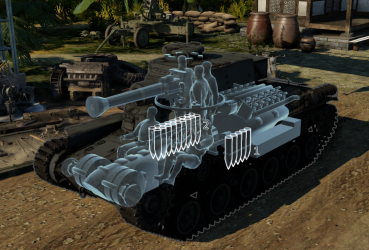
| Full ammo |
1st rack empty |
2nd rack empty |
Visual discrepancy |
|---|---|---|---|
| 23 | 18 (+5) | 0 (+23) | No |
Machine guns
| 7.7 mm Type 97 | ||||
|---|---|---|---|---|
| Mount | Capacity (Belt capacity) |
Rate of fire (shots/minute) |
Vertical guidance |
Horizontal guidance |
| Hull | 3,000 (20) | 498 | ±10° | ±15° |
Usage in battles
Because the Chi-Ha Short Gun was designed for an infantry support role, its performance shows how tank combat wasn't put in mind for the vehicle. With each shell only having 2.5 kg of explosive, this isn't enough to destroy any vehicle the shell hits; it most likely will shock the crew, but nothing else.
Most light armored vehicles and tanks (<30 mm armor) will be able to be destroyed from either hull break or crew knock-out wherever you hit. But when you start opposing medium to heavy tanks, you should fallback for friendlies to deal with the target. It might be possible to hit the roof of the turret or hull on these vehicles, but it's a tricky shot and won't always deal a fatal blow on first hit.Modules
| Tier | Mobility | Protection | Firepower | |
|---|---|---|---|---|
| I | Tracks | Parts | Horizontal Drive | |
| II | Suspension | Brake System | FPE | Adjustment of Fire |
| III | Filters | Crew Replenishment | Elevation Mechanism | |
| IV | Transmission | Engine | Artillery Support | |
Pros and cons
Pros:
- Familiar Chi-Ha chassis
- Typically, if the round penetrates, it kills
- Ten-second reload (Expert Crew) with a 120 mm cannon
- Five crew members
- 30 mm of penetration at any range and angle
Cons:
- Only fires high explosive rounds
- Poor turret traverse, just 5.1°/s
- Large shell drop (shells only travel 290 m/s)
- No roof-mounted anti-aircraft/infantry machine gun
History
Media
See also
- Related development
- Type 97 Chi-Ha (base hull)
- Type 97 Chi-Ha Kai (base turret)
- Type 2 Ho-I (reference role)
- Tanks of comparable role, configuration and era
References
External links
| Japan medium tanks | |
|---|---|
| Type 97 | Chi-Ha · Chi-Ha Kai · Chi-Ha Kai TD · Chi-Ha Short Gun |
| Type 1 | Chi-He · Chi-He (5th Regiment) · Ho-I |
| Type 3 | Chi-Nu · Chi-Nu II |
| Type 4 | Chi-To · Chi-To Late |
| Type 5 | Chi-Ri II |
| Type 61 MBT | ST-A1* · ST-A2* · ST-A3* · Type 61 |
| Type 74 MBT | ST-B2* · Type 74 (C) · Type 74 (E) · Type 74 (F) · Type 74 (G) |
| Type 90 MBT | Type 90 · Type 90 (B) · Type 90 (B) "Fuji" |
| Type 10 MBT | TKX (P)* · TKX* · Type 10 |
| Other | Ka-Chi |
| USA | ▅M4A3 (76) W · ▅M47 |
| *Prototype | |
| Japan premium ground vehicles | |
|---|---|
| Light tanks | Ha-Go Commander · Type 16 (FPS) |
| Medium tanks | Chi-Ha Short Gun · Chi-He (5th Regiment) · Ka-Chi · Chi-Nu II · Type 74 (G) · Type 90 (B) "Fuji" |
| Heavy tanks | Ro-Go · ▅Heavy Tank No.6 |
| Tank destroyers | Ho-Ri Prototype · Type 75 MLRS |


